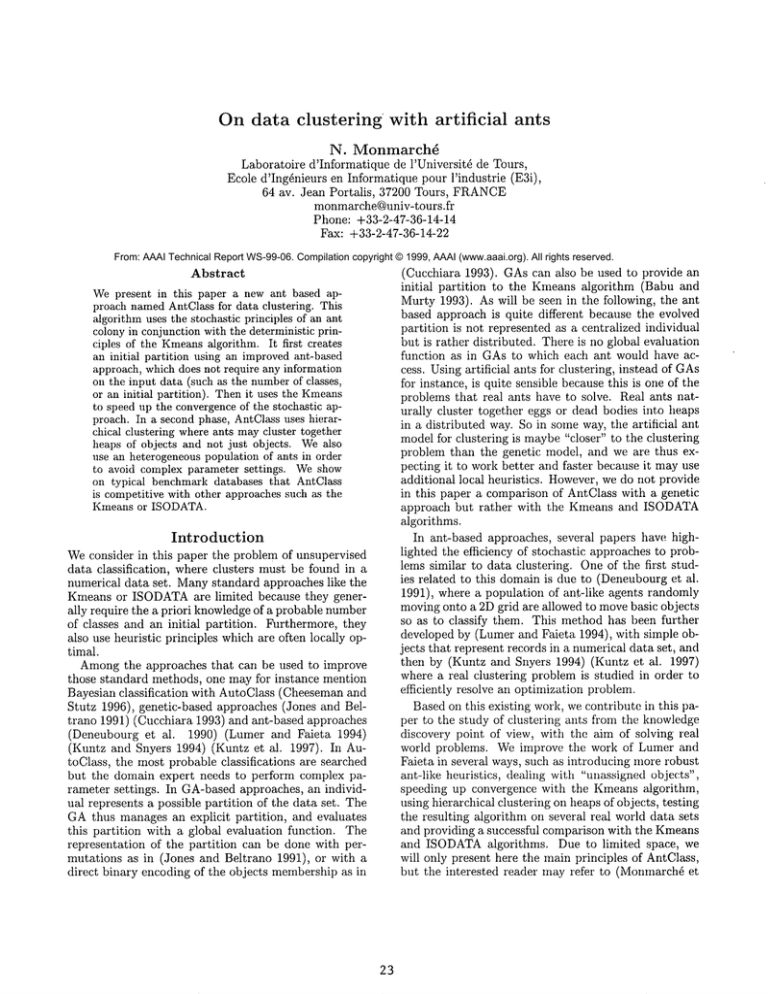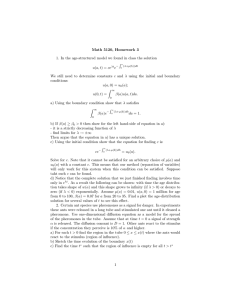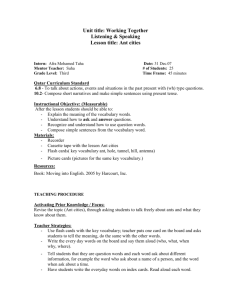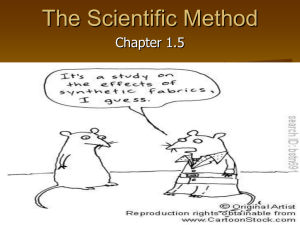
On data clustering
with artificial
ants
N. Monmarch6
Laboratoire d’Informatique de l’Universit6 de Tours,
Ecole d’Ing6nieurs en Informatique pour l’industrie (E3i),
64 av. Jean Portalis, 37200 Tours, FRANCE
monmarche@univ-tours.fr
Phone: +33-2-47-36-14-14
Fax: +33-2-47-36-14-22
From: AAAI Technical Report WS-99-06. Compilation copyright © 1999, AAAI (www.aaai.org). All rights reserved.
(Cucchiara 1993). GAscan also be used to provide
initial partition to the Kmeansalgorithm (Babu and
Murty 1993). As will be seen in the following, the ant
based approach is quite different because the evolved
partition is not represented as a centralized individual
but is rather distributed. There is no global evaluation
function as in GAsto which each ant would have access. Using artificial ants for clustering, instead of GAs
for instance, is quite sensible because this is one of the
problems that real ants have to solve. Real ants naturally cluster together eggs or dead bodies into heaps
in a distributed way. So in someway, the artificial ant
model for clustering is maybe"closer" to the clustering
problem than the genetic model, and we are thus expecting it to work better and faster because it mayuse
additional local heuristics. However,we do not provide
in this paper a comparison of AntClass with a genetic
approach but rather with the Kmeans and ISODATA
algorithms.
In ant-based approaches, several papers have highlighted the efficiency of stochastic approaches to problems similar to data clustering. One of the first studies related to this domainis due to (Deneubourget al.
1991), where a population of ant-like agents randomly
moving onto a 2D grid are allowed to movebasic objects
so as to classify them. This method has been further
developed by (Lumer and Faieta 1994), with simple objects that represent records ill a numerical data set, and
then by (Kuntz and Snyers 1994) (Kuntz et al. 1997)
where a real clustering problem is studied in order to
efficiently resolve all optimization problem.
Based on this existing work, we contribute in this paper to the study of clustering ants from the knowledge
discovery point of view, with the aim of solving real
world problems. We improve the work of Lmner and
Faieta in several ways, such as introducing more robust
ant-like heuristics, dealing with "unassigned objects",
speeding up convergence with the Kmeansalgorithm,
using hierarchical clustering on heaps of objects, testing
tile resulting algorithm on several real world data sets
and providing a successful comparison with the Kmeans
and ISODATAalgorithms. Due to limited space, we
will only present here the main principles of AntClass,
but the interested reader may refer to (Monlnarch~ et
Abstract
Wepresent in this paper a new ant based approach namedAntClass for data clustering. This
algorithm uses the stochastic principles of an ant
colony in conjunction with the deterministic principles of the Kmeansalgorithm. It first creates
an initial partition using an improvedant-based
approach, which does not require any information
on the input data (such as the numberof classes,
or an initial partition). Thenit uses the Kmeans
to speed up the convergenceof the stochastic approach. In a second phase, AntClass uses hierarchical clustering where ants maycluster together
heaps of objects and not just objects. Wealso
use an heterogeneouspopulation of ants in order
to avoid complex parameter settings. Weshow
on typical benchmark databases that AntClass
is competitive with other approaches such as the
Kmeans or ISODATA.
Introduction
Weconsider in this paper the problem of unsupervised
data classification,
where clusters must be found in a
numerical data set. Manystandard approaches like the
Kmeans or ISODATAare limited because they generally require the a priori knowledgeof a probable number
of classes and an initial partition. Furthermore, they
also use heuristic principles which are often locally optimal.
Amongthe approaches that can be used to improve
those standard methods, one may for instance mention
Bayesian classification with AutoClass (Cheeseman and
Stutz 1996), genetic-based approaches (Jones and Beltrano 1991) (Cucchiara 1993) and ant-based approaches
(Deneubourg et al. 1990) (Lumer and Faieta 1994)
(Kuntz and Snyers 1994) (Kuntz et al. 1997). In
toClass, the most probable classifications are searched
but the domain expert needs to perform complex parameter settings. In GA-basedapproaches, an individual represents a possible partition of the data set. The
GAthus manages an explicit partition, and evaluates
this partition with a global evaluation function. The
representation of the partition can be done with permutations as in (Jones and Beltrano 1991), or with
direct binary encoding of the objects membershipas in
23
al. 1999) for more details.
Main principles
of AntClass
The ant colony described here follows the broad outlines
of the principles commonlyused in this domain. Still,
we also introduce some important differences linked to
the studied problem.
Each data is a vector of n real values and is symbolized by an object. Initially, all the objects are randomly
scattered over a 2D toroidal and square grid which size
is automatically scaled to the database. During the execution of the algorithm, objects can be piled up on the
same cell, constituting heaps. A heap thereby represents a class or cluster. The distance between 2 objects
X and Y can be calculated by the Euclidean distance
between 2 points in Rn. The center of a class is determined by the center of mass of its points. There is no
link between the position of an object on the grid and
n.
the value of its attributes in R
A fixed number of ants (20 in the following) move
onto the 2D grid and can perform different actions.
Each ant movesat each iteration, and can possibly drop
or pick up an object according to its state. If an ant
does not carry an object, it can:
¯ pick up a single object from a neighbouring cell according to a fixed probability,
¯ pick up the most dissimilar object of a heap from
a neighbouring cell (that is, the most distant object
from the center of mass of the heap).
If an ant carries an object O, it can:
¯ drop O on a neighbouring empty cell with a fixed
probability,
¯ drop O on a neighbouring single object OI if O and
O~ are close enough to each other (according to
dissimilarity threshold expressed as a percentage of
the maximumdissimilarity in the database),
¯ drop O on a neighbouring heap H if O is close enough
to the center of mass of H (on again, according to
another dissimilarity threshold).
Initially this ant based algorithm is applied to the
database because it has the following advantage: it
does not require any information such as the number
of classes, or an initial partition. The created partition
is however compoundof too many clusters (but which
are quite homogenous) and with some obvious classification errors, because we stop the algorithm before
convergence which would be too long to obtain.
So then we use the Kmeansalgorithm to remove small
classification errors, and also to assign "free" objects,
i.e. objects left alone on the board but also objects
still carried by the ants when the algorithm stops. This
removes really the classification errors, but since the
Kmeansis locally optimal only and since we provide
it with too manyclusters, the obtained partition still
contains too many but very homogenousclusters.
Therefore, we have applied on again the ant-based
algorithm but on heaps of objects rather than single
24
objects: during this second part, previously created
heaps can be picked up and dropped by ants as if they
were objects.We use the same ant-based algorithms as
previously mentioned, but adapted for heaps. For instance, one can define a distance between too heaps as
the distance between their center of mass. This part
of AntClass can be seen as hierarchical clustering: the
ants first work on the objects, constituting small but
very homogenous heaps. Then, working directly on
these heaps as if they were objects, they will hierarchically build more important (:lasses. At the end of
this step, the real number of classes is very well approximated, but as mentioned previously, there are still
some heaps which are not assigned. Therefore we use
once more the Kmeansalgorithm to obtain the final
partition. But this time, since the input partition given
to the Kmeansis very close to the "optimal" one, the
output is of high quality.
So AntClass consists mainly in four steps: (1) antbased algorithm for clustering objects, followed by (2)
the Kmeansalgorihm using the initial partition provided by the ants, and then (3) ant-based clustering but
on heaps previously found, and finally (4) the Kmeans
algorithm on objects once more.
Results and conclusion
For all the databases hereafter mentioned, the results
are obtained in a about 10 seconds on a standard PC
(Pentium 166MHz)for one run. All results have been
averaged over 50 runs. We have used the following
databases (numbers in brackets indicate respectively,
the number of objects, the number of numerical attributes, and the number of classes): Artif. 1 (80,
4), Artif. 2 (270, 2, 9), Artif. 3 (200, 2, 4), Artif.
(150, 10, 3), Iris (178, 4, 3)(Fisher 1936), Wine
13, 3), Glass (214, 9, 2-6), Soybean(47, 21, 4), Thyroid
( 215, 5, 3). "Artif. 1" to "Artif. 4" have been used
to evaluate AntClass on databases with known properties where the examples are generated according to
gaussian laws (in the same way as Lumer and Faieta).
The other real world databases come from the machine
learning repository. All values in the database are normalizedin [0, 1].
Wehave defined two performance measures to evaluate howclose is the obtained partition to the real one.
The first measure is a classification error rate. It is
computed as follows: for a given cluster H obtained
by AntClass, consider the majorative class among H
according to the "Class" attribute.
All objects of H
that do not belong to this class are considered as being
missclassified. The classification error rate is simply the
ratio between the total numberof misclassified objects
for all created clusters and the total numberof objects
in the database. The second performance measure is
simply the numberof created clusters.
The results mentioned in table 1 on the artificial
databases show the progression of AntClass towards a
relevant classification. In the first step of AntClass, the
Ant-based algorithm finds an initial partition but with
Databases
and perf.
Artif. 1: C1. err.
# of cla.
Artif. 2: C1. err.
# of cla.
Artif. 3: C1. err.
# of cla.
Artif. 4: C1. err.
# of cla.
1: Ant colony
on objects
11.58 %
8.15
17.24 %
22.30
20.35 %
15.06
22.23 %
5.22
2: + Kmeans
on objects
0.21%
7.76
0.52 %
17.07
6.32 %
14.98
3.32 %
5.18
3: + Ant colony
on heaps
0.42 %
4.24
2.22 %
10.46
6.93 %
5.42
2.68 %
2.94
4: + Kmeans
on objects
0.00 %
4
0.00 %
9.02
4.66 %
4.42
1.33 %
2.96
Table 1: Intermediary and final results obtained on each of the four steps of AntClass for the four artificial
"C1. err." stands for "classification error rate" and "# of cla." for "numberof classes".
classification errors and really too manyclusters. At
the end of the second step of AntClass, i.e. the use of
the Kmeanson the initial partition found in the previous step, the classification errors are reduced but the
numberof clusters is still really too high. This is due
to the fact that the Kmeansalgorithm is really sensitive to the initial partition. If this initial partition
contains too manyclusters, then the final partition is
unlikely to be the optimal one. Once the third step has
been performed, the ants converge very closely to the
right number of classes by working on heaps of objects
rather than objects themselves. One can notice that
some classification
errors remain. At the end of the
fourth step, using the Kmeansonce more decreases the
classification errors on again. But this time, since the
number of classes and an almost optimal partition have
been well determined in the previous step, the Kmeans
really finds optimal or near optimal results.
We describe now the results obtained with the
Kmeans algorithm and with ISODATA(Ball and Hall
1965). Each algorithm is initialized with t0 classes,
and all objects are initially assigned randomlyto these
classes.
The Kmeans and ISODATAalgorithms are
used with 10 iterations. Results obtained by the three
algorithms (AntClass, Kmeans and ISODATA)are represented in table 2. As can be seen, AntClass outperforms the two other algorithms, both in terms of classification errors and of correct numberof classes, on most
of the databases. The only exception is for Fisher’s Iris
database. In this database, the Setosa class is completely distinguishable from the two others. The last
two classes are more difficult to separate, unless more
than three clusters are created, which is what Kmeans
of ISODATAdo.
As a conclusion, we have presented in this paper a
new tlybrid and ant-based algorithm named AntClass
for data clustering in a knowledge discovery context.
The main features of this algorithm are the following
ones. AntClass deals with numerical databases. It does
not require any initial information about the future
classification, such as a an initial partition or an initial
number of classes. AntClass introduces new heuristics
for the ant colony, and also an hybridization with the
25
databases.
Kmeansalgorithm in order to improve the convergence.
Wehave also introduced in AntClass hierarchical clustering where ants may carry heaps of objects and not
just objects. Furthermore, AntClass uses an heterogeneous population of ants in order to avoid complex
parameter settings to be performed by the domain expert. Finally, AntClass has been tested with success
on several databases, including real world ones. We
may mention also that it has been applied to a real
world but confidential application and gets competitive
results with SAS6.12.
Future work consists in two ways:
¯ we need to define new performance mesures that
could take into account both the number of classes
and the quality of the classification,
¯ other sources of inspiration from real ants are to be
considered for the clustering problem. For instance,
ants that meet on the board could exchange objects.
References
Babu, G.P.; and Murty, M.N. 1993. A near optimal
initial seed value selection in Kmeansalgorithm using genetic algorithm. Pattern Recognition Letters 14,
763-769.
Ball, G.H.; and Hall, D.J. 1965. ISODATA,a novel
method of data analysis and pattern classification.
Technical Report, Stanford Research Institute.
Cheeseman, P.; and Stutz, J. 1996. Bayesian Classification (AutoClass): Theory and Results. In Advances
in Knowledge Discovery and Data Mining, Usama M.
Fayyad, Gregory Piatetsky-Shapiro,
Padhraic Smyth,
& Ramasamy Uthurusamy,
Eds. AAAI Press/MIT
Press.
Cucchiara, R. 1993. Analysis and comparison of different genetic models ~br the clustering problem in image
analysis. In Proceedings of the International Conference on Artificial Neural Networks and Genetic Algorithms, R.F. Albrecht, C.R. Reeves, and N.C. Steele
(Eds), Springer-Verlag, 423-427.
Deneubourg, J.-L.; Goss, S.; Franks, N.; SendovaFranks, A.; Detrain, C.; and Chretien, L. 1990. The
Algo.
Data set
Artif. 1
Artif. 2
Artif. 3
Artif. 4
Iris
Wine
Glass
Soybean
Thyroid
# of cla.
(real)
4
9
4
3
3
3
2-6
4
3
AntClass
# of cla.
aver.)
4
9.02
4.42
2.96
3.02
3.06
7.7
4.82
3.28
AntClass
Kmeans
cl. err. # of cla.
aver.)
aver.)
0.00 %
5.63
0.00 %
9.73
7.26
4.66 %
1.33 %
9.60
15.4 %
6.95
5.38 %
8.98
4.48 %
7.06
7.93
o.13 %
8.77
6.38 %
Kmeans ISODATA
cl. err.
# of cla.
aver.)
aver.)
4.53
2.15 %
12.78 %
6.38
7.30 %
6.58
9.53
0.00 %
4.59
4.63 %
8.57 %
9.09
2.34
50.16 %
7.94
3.89 %
8.26 %
1.48
Table 2: Results obtained by AntClass, Kmeansand ISODATA
with artificial
dynamic of collective sorting robot-like ants and antlike robots. In Proceedings of the first Conference on
Simulation of Adaptive Behavior 1990, J.A. Meyer et
S.W. Wilson (Eds), MIT Press/Bradford Books, 356363.
Fisher, R. A. 1936. The Use of Multiple Measurements
in AxonomicProblems. Annals of Eugenics 7, 179-188.
Jones, D.R.; and Beltrano, M.A. 1991. Solving partitiohing problems with genetic algorithms. In Proceedings of the fourth International Conference on Genetic
Algorithms, 1991, R.K. Belew and L.B. Booker (Eds),
Morgan Kaufmann, 442-449.
Kuntz, P.; and Snyers, D. 1994. Emergent colonization
and graph partitioning. In Proceedings of the third
International Conference on Simulation of Adaptive
Behavior: From Animals to Animats 3 (SAB94),
Cliff, P. Husbands, J.A. Meyer, S.W. Wilson (Eds),
MIT-Press, 494-500.
Kuntz, P.; Layzell, P.; and Snyers, D. 1997. A colony of
Ant-like agents for partitionning in VLSItechnology.
In Proceedings of the fourth European Conference on
Artificial Life 1994, P. Husbandset I. Harvey (Eds),
MIT press, 417-424.
Lumer, E.D.; and Faieta, B. 1994. Diversity and Adaptation in Populations of Clustering Ants. In Proceedings of the third International Conference on Simulation of Adaptive Behavior: From Animals to Animats 3 (SAB94), D. Cliff, P. Husbands, J.A. Meyer,
S.W. Wilson (Eds), MIT-Press, 501-508.
Monmarch4, N.; Slimane, M.; and Venturini,
G.
1999. AntClass: discovery of clusters in numeric
data by an hybridization of an ant colony with the
Kmeans algorithm. Technical Report 213, Laboratoire d’Informatique, Eai, University of Tours, January 1999.
26
ISODATA
cl. err.
aver.)
1.64 %
29.11%
7.84 %
0.00 %
6.28 %
8.63 %
42.98 %
4.77 %
14.72 %
and real world databases.








